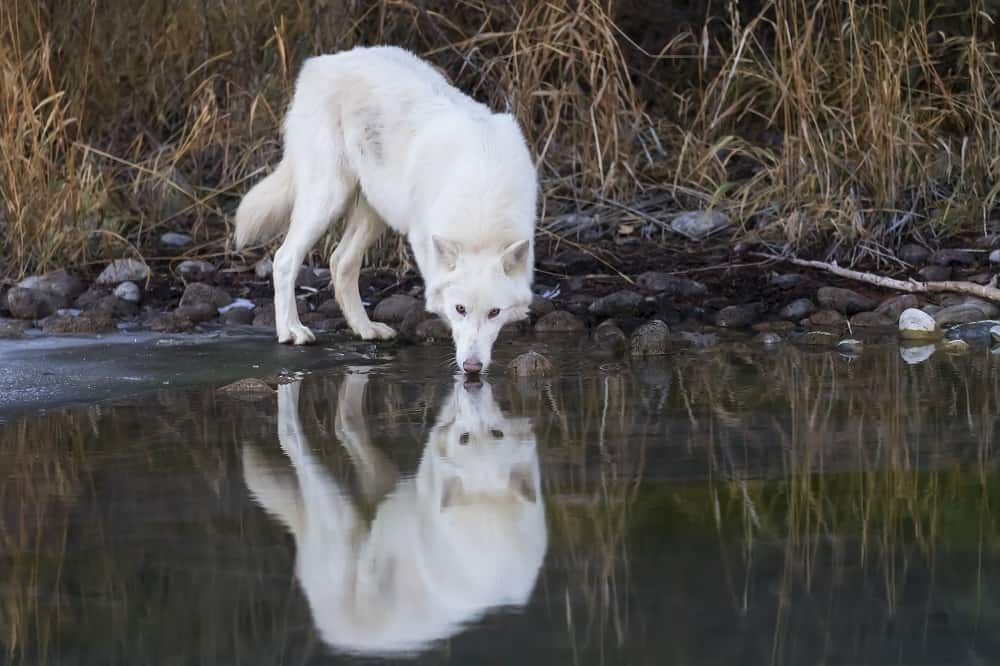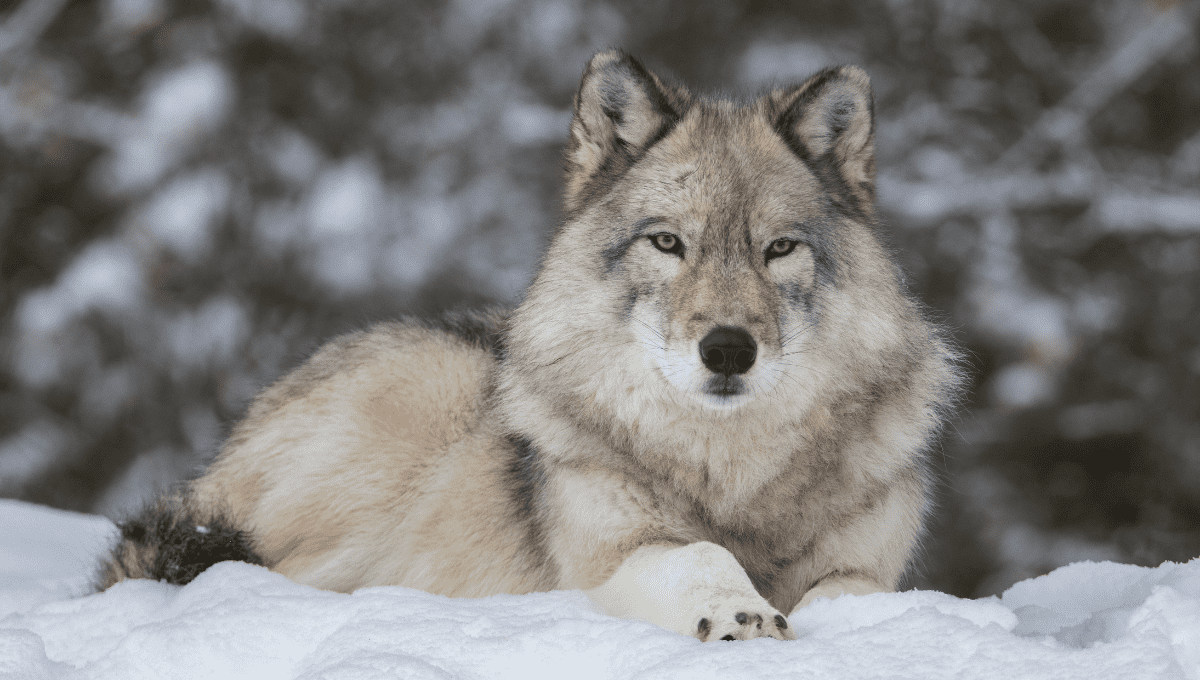If you are looking for fun facts about wolves, either for your school project or just because you like wolves, you have found the right place! In this article, you will find the top facts about wolves, and information about different species of wolves
This is just one article in a series of animal fun facts posts. Whether you’re curious about cats, or maybe want to know more about penguins, find more of our animal fun fact guides here.
Fun Wolf Facts

Wolves, scientifically known as Canis Lupus, are extremely social mammals that reside in packs. They develop really close bonds with family members in their pack, often displaying affectionate and emotional behaviours when observed in the wild. Wolves are native to North America and Eurasia.
Wolves are the largest extant member of the family Canidae, weighing on average about 30-80 kg for males and 23-50 kg for females. Whilst a wolf’s average lifespan is 6-8 years, they can live up to 13 years in the wild, and 16 years in captivity!
10 fun facts about wolves
- Wolves have 42 teeth.
- A wolf’s sense of smell is 100 times better than humans. This is because they have over 200 million nasal olfactory cells.
- Wolves can run up to 50-60 km/h. Despite not being the fastest runners when compared to other mammals, they are very endurant and can travel far in less-than-ideal conditions.
- Wolves have a very high IQ, and a strongly developed sense of hearing and smell, which comes in useful when hunting.
- Wolves are at the top of the food chain, as there aren’t many animals that have an advantage over them. Whilst a lion or bear could easily take on a wolf, they cannot take on an entire pack of wolves that travels together.
- Wolves are mostly nocturnal, hunting after nightfall and resting after sunrise.
- A female wolf is called a Luna Wolf, or a She-Wolf.
- A wolf’s tail is straight, unlike a dog’s, which curls.
- Wolves can detect and hear sounds as far as 8 kilometres away.
- The hierarchy in a wolf pack is led by the alpha male and female.
Do you want cute wolf stickers? – Click here!
Where do Wolves live?
Wolves are found in different habitats across the world. However, they are commonly located in the northern regions, such as Alaska, Canada, and Russia. The habitat that they live in reflects their adaptability as a species; different breeds of wolves live in different habitats. These include temperate forests, mountains, grasslands, tundra, taiga, and desserts.
What do Wolves eat?
Wolves are carnivores, meaning that they require a meat-based diet. Because they live and hunt in packs, they are able to catch larger animals. Some of the larger prey that they hunt and consume in the wild are ungulates. These include elk, moose, deer, bighorn sheep, and bison. However, they also eat smaller animals. This includes squirrels, mice, weasels, and foxes. An adult wolf can eat up to 20 pounds of meat in a single feeding. They also occasionally consume berries, apples, pears, and melons.
Baby Wolf Facts
Baby wolves are called pups. Similar to cats and dogs, pups are born in a litter, where 4 to 6 baby wolves, known as littermates, are born at once. Below are some fun facts about little wolves:
- Wolf pups only weigh around one pound when they are born.
- Once they are 12 weeks old, they start joining the pack on hunting trips. However, they only start participating in the actual hunting when they are 6 months. Until then, they just observe.
- Wolf pups are born deaf and with bright blue eyes. Their eye-colour changes to gold when they turn 10-16 weeks old.
- However, they are born with an incredibly developed sense of taste and touch.
- Wolf pups love to run around chasing and playing with each other, similar to dogs.
- Wolves reach adult size when they are around 1 year old.
You can find cute wolf plushies by clicking here!
Different Wolf Species Facts
There are three main species, and close to 40 subspecies of wolves. However, there is a great ongoing debate about these numbers. The tree main species are the Grey Wolf, the Eastern Wolf, and the Red Wolf. Below are some popular subspecies, and 5 facts about each one!
Arabian Wolf
- The Arabian wolf is a desert-adapted subspecies of Grey Wolf, native to the Arabian Peninsula, the Negev Desert, the Sinai Peninsula, and Jordan.
- Arabian wolves are omnivores, meaning they consume both small to medium sized animals and plants.
- This subspecies much larger ears than other wolves. This is an adaptation made to disperse body heat, as they live in desert habitats.
- They hunt in pairs, or groups of up to four wolves. They do not live in large packs. The lifespan of an Arabian wolf is 6 years in the wild.
- Arabian wolves are not known to howl.
Arctic Wolf

- The Arctic wolf is also known as the “polar wolf” or “white wolf”. Arctic wolves are the only subspecies of wolves that are not threatened.
- This subspecies of Grey Wolf inhabits the Arctic regions of North America and Greenland.
- Arctic wolves have smaller ears and shorter muzzles. This is an adaptation made in order to preserve body heat.
- They are carnivorous hunters, and they help control the populations of other animals, like musk ox, caribou, and arctic hares, in their habitats. This wolf subspecies can tolerate extreme darkness and is able to hunt under the light of the moon and stars.
- The average lifespan of an Arctic wolf is around 7 to 10 years in the wild, living in packs of about 5 to 7 wolves.
Baffin Island Wolf
- The Baffin Island wolf is one of the smallest subspecies of grey wolf.
- They are found exclusively on Baffin Island and nearby surrounding islands.
- They were not formally recognised as a subspecies until 1943.
- Baffin Island wolves are omnivores, and their main food sources are lemmings, barren- ground caribou (a type of reindeer), and arctic hares. However, they aren’t picky eaters and will feed on anything if hungry enough.
- They often hunt either alone or in pairs, unlike most wolf species, who hunt in packs.
Mexican Wolf
- The Mexican wolf, also known as ‘the lobo’ is the smallest subspecies of grey wolf, native to south-eastern Arizona and Southern New Mexico.
- They reside in packs ranging in size between 7 to 30 wolves- depending on their prey.
- Mexican wolves are carnivores, mainly consuming mule deer, white-tailed deer and elk, and smaller mammals. They usually only eat twice a week and can eat up to 20 pounds of meat in one feeding.
- Their fur is a mixture of grey, black, rust, and cream.
- Mexican wolves are unfortunately the world’s most endangered wolf subspecies. Their lifespan is 15 years in captivity, and 10 years in the wild.
British Columbia Wolf

- The British Columbia wolf is one of the largest subspecies of grey wolf.
- Despite their name, they currently only live in North America. They used to live in parts of British Columbia, Yukon, Alberta, and southwestern Alaska, but have been hunted to extinction there.
- They have long coats which are commonly black, mixed with grey, and cinnamon brown.
- They eat hares, birds, deer, moose, caribou, ek, and other ungulates (hoofed animals). They usually hunt on elderly and sick animals that are easy to catch.
- British Columbia wolves’ mate for life.
Ethiopian Wolf
- The Ethiopian wolf, also known as “ky kebero”, meaning red jackal, is currently the only wolf species living in Africa. They can be found in mountain ranges in Ethiopia.
- They have a reddish-brown fur coat.
- Ethiopian wolves live in packs ranging from 3-13 wolves, though they prefer to hunt alone.
- They mainly eat rodents, hares, common grass rats, giant mole rats, goslings, and young ungulates (hoofed animals).
- Ethiopian wolves are very loud and can produce a wide range of vocalisations. Their hearing is 20 times better than that of humans.
Eurasian Wolf
- The Eurasian wolf, also known as the common wolf, is the largest subspecies of grey wolf in the world.
- The colour of their short fur depends on their location. It usually ranges between grey, red, black, white, or cream. It helps them camouflage with the colours of the mountains in their habitats.
- The highest population of Eurasian wolves can be found in Russia, as well as China.
- They have been hunted to extinction throughout many parts of the Europe because they preyed on livestock.
- Despite hunting alone, Eurasian wolves are extremely social. They live in packs of 7.
How you can help Wolves
After reading this, you’re probably quite sad because of all the wolves subspecies that are unfortunately endangered, or close to extinct. Luckily, you can help out! Below is a list of 3 things you can do to help save wolves from extinction.
- Spread the word. Even if you don’t have the time or the funds to donate to a charity, informing yourself and others spreads awareness.
- Reduce, reuse, recycle. One of the greatest threats towards wolves and their habitats is climate change. Doing our part to help stop climate change will help wolves as well.
- Become a member. There are multiple trusted charities and organisations that you can support that help wolves. Click here to find one.
Information about Wolves for kids
We hope you found this list of fun facts about wolves enjoyable and useful! Good luck with your school project! 🙂
Check out this range of wolf books for kids, they are awesome!
Discover more of our fun facts for kids animal guides below.
- Quokka Facts for Kids
- Ant Facts for Kids
- Crocodile Facts for Kids
- Dolphin Facts for Kids
- Echidna Facts for Kids
- Bee Facts for Kids
- Australia’s Deadliest Animals Facts for Kids
- Cheetah Facts for Kids
- Endangered Animals Facts for Kids
- Kangaroo Facts for Kids
- Possum Facts for Kids
- Koala Facts for Kids
- Dog Facts for Kids
- Cat Facts for Kids
- Butterflies Facts for Kids
- Dingo Facts for Kids
- Turtle Facts for Kids
- Penguin Facts for Kids
- Whale Facts for Kids
- Sustainability Facts for Kids
- Recycling Facts for Kids

